Switzerland
Seitenübersicht
[Ausblenden]1 General information relevant in regard to this Wiki
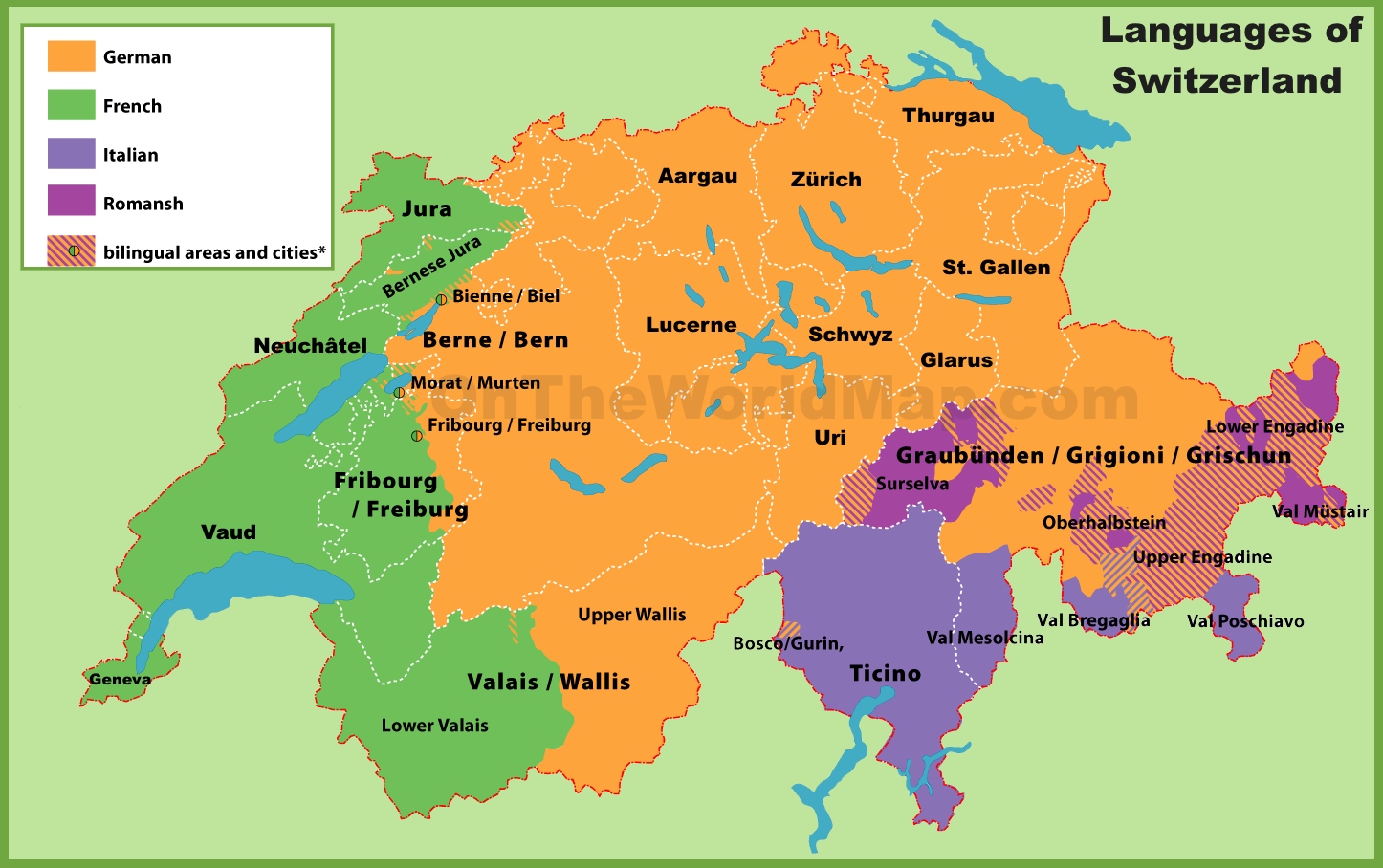
source: http://ontheworldmap.com/switzerland/map-of-languages-in-switzerland.html accessed: 12 July 2020
Switzerland is a federal country in Central Europe, composed of 26 cantons. It has four official languages: German, French, Italian, and Rhaeto-Romanic. While the last is spoken in only a very small region, the first three are often used to distinguish the Swiss regions. On the right, you find a map, which shows the spread of official languages. With 8.57 million inhabitants and an area of 41,285 km2, Switzerland is a relatively small country. With a GDP per capita of 83,161 $, Switzerland is the second wealthiest state in the world.[1] In contrast to most of its neighbor states, Switzerland is neither member of the EU, nor of the NATO. On the other hand, Switzerland has very close relations with the principality Liechtenstein including a common health system, customs territory, and school system. [2] Compared to other federal countries, the sub-state level “cantons” has a high degree of freedom. Only a few areas of law, such as criminal law or the armed forces, are reserved for the Confederation. The health system and pandemic protection are mostly regulated by the cantons. [3] Switzerland is often named as an example for direct democracy. This definition is misleading at some point. Like in most democracies, the law is usually passed by the parliament. At the national level referendum only take place a) as a veto, if a petition has 50,000 supporters b) obligatory, if the constitution was changed c) if a petition with over 100,000 supporters demands a change of the constitution. [4]
2 Preparedness
2.1 Health System
The capacity of the health system is a crucial element of preparedness. The most important figure is the number of ICU (intensive care unit) beds. Severe cases of Covid-19 have a much lower chance to survive without intensive care. In 2012 Switzerland had 11 ICU beds per 100.000 inhabitants, which is approximately the European average (11,5).[5] In 2020 Switzerland has about 1000 ICU beds (=11,6 beds/100.000 population), about 850 of them with artificial respiration.[6] According to a German survey, cited by the RKI, about 10% of the Covid-19 cases need artificial respiration.[7] [8] Relying on this data the Swiss health system has a capacity for about 8500 ongoing infections minus those beds occupied by non-covid patients. Due to small sample size, this data is little reliable and can only be interpret as rough estimation.
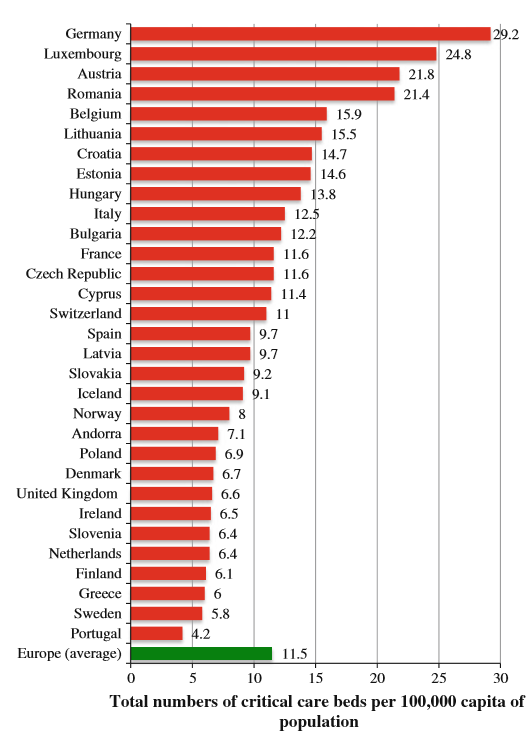
source Rhodes, A., Ferdinande P., Flaatten H., Guidet P. , Metnitz P. G., and Moreno R. P.. 2012. “The variability of critical care bed numbers in Europe.”. Intensive care medicine 38 (10): 1647–53.
2.2 pandemic prevention
Concerning executive plans, Swiss preparation is based on a pandemic plan against influenza. As the transmission of SARS-CoV-2 is in core aspects like the influenza virus transmission, the plan is largely applicable. There is no information provided, why the Swiss pandemic plan is specific against the influenza virus. In fact, in Norway, Sweden and Spain the pandemic plans also are specified for flu pandemics. Since 1995 the federal health department (Bundesamt für Gesundheit BAG) develops strategies against influenza pandemics. Therefore, they founded an expert commission (Eidgenössischen Kommission für Pandemievorbereitung und -bewältigung (EKP)), which published the influenza pandemic plan in 2004.
The current plan is from 2018 and has been largely revised after the H1N1 pandemic in 2009, which showed that the former pandemic plan was quite vague and not sufficient to be well prepared against a serve pandemic. Luckily the H1N1 pandemic was much milder than expected so that the former plan did not cause a disaster. In contrast to that, in Spain revising their pandemic plan, lead to a weakening of the pandemic plan The current plan clearly asses’ tasks among vertical (e.g. health department, government) and horizontal (most important: Canton and Federal State) players. Therefore, it names strategies and measures depending on the severity of the pandemic, dealing with the subjects communication, monitoring, contact tracing, social distancing, individual behavior, and medical care (including medical protective equipment, medication, vaccine). The key concept is the close cooperation of the federal health department with the cantonal health departments. While the cantonal departments execute the measures and most important trace the cases, the federal department puts the pieces of information together and supports lower-level executives with expertise. The most important issue for the BAG is sense-making. All data collected by the cantons are being reported to and proceeded by the BAG. [9]
Further, another plan supports businesses with developing their own hygienic concepts. Therefore, a handbook enables people without epidemiologic knowledge to develop broad measures. It contains concrete measures like improving the ventilation system, installing disinfectant dispensers, or establishing communication structures and contact persons. [10]
The current plan is from 2018 and has been largely revised after the H1N1 pandemic in 2009, which showed that the former pandemic plan was quite vague and not sufficient to be well prepared against a serve pandemic. Luckily the H1N1 pandemic was much milder than expected so that the former plan did not cause a disaster. In contrast to that, in Spain revising their pandemic plan, lead to a weakening of the pandemic plan The current plan clearly asses’ tasks among vertical (e.g. health department, government) and horizontal (most important: Canton and Federal State) players. Therefore, it names strategies and measures depending on the severity of the pandemic, dealing with the subjects communication, monitoring, contact tracing, social distancing, individual behavior, and medical care (including medical protective equipment, medication, vaccine). The key concept is the close cooperation of the federal health department with the cantonal health departments. While the cantonal departments execute the measures and most important trace the cases, the federal department puts the pieces of information together and supports lower-level executives with expertise. The most important issue for the BAG is sense-making. All data collected by the cantons are being reported to and proceeded by the BAG. [9]
Further, another plan supports businesses with developing their own hygienic concepts. Therefore, a handbook enables people without epidemiologic knowledge to develop broad measures. It contains concrete measures like improving the ventilation system, installing disinfectant dispensers, or establishing communication structures and contact persons. [10]
2.3 legal basis
From a legal perspective, Switzerland has an epidemic code. The current version came into effect in 2016. Like the pandemic plan, it also has been completely revised after the swine flu (H1N1). The idea behind this code is a quick and unbureaucratic reaction to an upcoming pandemic, by reducing the competencies of the cantons. Therefore, the federal council can declare two different emergency cases. Calling the first level of emergency, the federal council, coordinated by the Department of the Interior, can impose vaccinations for risk groups, call medical staff to fight against the pandemic, and impose further, not specified measures against individuals or the population. The most important difference to level two is that the cantons have a right to be heard before the measures are imposed. The second level empowers the federal country almost unrestricted. Only based on the constitution and without further legal basis, the federal council can declare emergency ordinaries, which are “necessary”. Declaring level one requires an epidemic, which cannot be managed by the ordinary executive bodies and the declaration of a “public health emergency of international concern” by the WHO. Level two requires an extraordinary situation (“außerordentliche Lage”), which has been defined as a “worst-case scenario” by the health department. The definition is quite vague and not explicitly defined in the code. A sunset clause does not exist, which means that as long as the pandemic is ongoing, the emergency case can remain. I will not describe further issues of the pandemic code, as they only provide a very complex legal basis, which results in the more concrete pandemic plan. [11]
3 Sense-making
All data about Switzerland is provided from the Website of their health department (BAG) and contains data about the principality Liechtenstein as well. Due to its small size (38,000 inhabitants), this effect can be ignored. Data about other counties comes from the Johns Hopkins University. [12] [13]
Since 29 January 2020 Covid-19 is notifiable. [14] Laboratories must report both positive and negative tests within a day to the federal health department (BAG) and the cantonal doctor. [15] In contrast to e.g. Germany, Switzerland only counts cases if people are tested positively on the Coronavirus or on antibodies against Covid-19. In other countries, such as Germany cases are counted if either a test has been positive, or one can strongly assume that a person has Covid-19 due to typical symptoms and contact with other infected persons. Concerning test criteria, people are only tested, if they have typical symptoms, other indicators, such as contact with infected persons are not considered. Like in most countries, Switzerland had at the peak of the pandemic in March 2020 too little test capacity- which might have caused a significant darkfield. [16] Nonetheless, within 19 June 2020 only 8% of the test were positive, which indicates a large scale of testing. Another indicator for the degree of testing is the ratio of deaths to infections, which was 5,32% on 28 June 2020. The idea behind this figure is that the true value of the mortality is constant under a working health system and if the deaths relative to the confirmed cases increases, the dark field increases as well. Bellow I have compared the ratio of all countries included in this Wiki.
Since 29 January 2020 Covid-19 is notifiable. [14] Laboratories must report both positive and negative tests within a day to the federal health department (BAG) and the cantonal doctor. [15] In contrast to e.g. Germany, Switzerland only counts cases if people are tested positively on the Coronavirus or on antibodies against Covid-19. In other countries, such as Germany cases are counted if either a test has been positive, or one can strongly assume that a person has Covid-19 due to typical symptoms and contact with other infected persons. Concerning test criteria, people are only tested, if they have typical symptoms, other indicators, such as contact with infected persons are not considered. Like in most countries, Switzerland had at the peak of the pandemic in March 2020 too little test capacity- which might have caused a significant darkfield. [16] Nonetheless, within 19 June 2020 only 8% of the test were positive, which indicates a large scale of testing. Another indicator for the degree of testing is the ratio of deaths to infections, which was 5,32% on 28 June 2020. The idea behind this figure is that the true value of the mortality is constant under a working health system and if the deaths relative to the confirmed cases increases, the dark field increases as well. Bellow I have compared the ratio of all countries included in this Wiki.
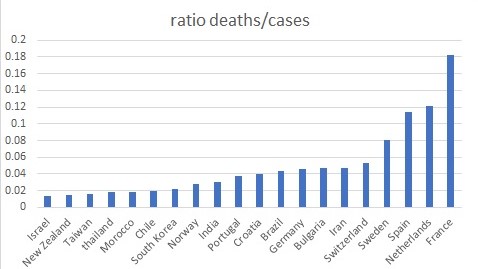
Assuming that the lowest value (Israel: 1,35%) converges to the true value, Switzerland has a huge dark field. On the other hand, Israel might overestimate the cases due to unreliable test or might miss some deaths. According to Julius Berger, he could not find any information about Israels testing logic. In conclusion, all data in the context of COVID-19 must be interpreted with caution.
The first Covid-19 in Switzerland case was detected on 24 February 2020. In the beginning, the number of infections grew exponentially with a peak on 23 March 2020, when Switzerland had 1464 new registered infections on one day. One should keep in mind that we have a delay of 7-14 days between infection and detection. On 12 July 2020, Switzerland had in total 32,798 cases and 1,686 deaths. As big countries tend to have more cases the absolute value of cases is not meaningful, hence in the following, I will work with the incidence, which is the total number of cases in relation to the population size. Usually, incidence measures the number of new cases in a year. [17] Here it relates to the total number of cases.
The first Covid-19 in Switzerland case was detected on 24 February 2020. In the beginning, the number of infections grew exponentially with a peak on 23 March 2020, when Switzerland had 1464 new registered infections on one day. One should keep in mind that we have a delay of 7-14 days between infection and detection. On 12 July 2020, Switzerland had in total 32,798 cases and 1,686 deaths. As big countries tend to have more cases the absolute value of cases is not meaningful, hence in the following, I will work with the incidence, which is the total number of cases in relation to the population size. Usually, incidence measures the number of new cases in a year. [17] Here it relates to the total number of cases.
With regard to gender, men have a higher risk to die. 57.5% of the people dying because of Covid-19 are male, while only 46.2% of the cases are male. This leads to a death rate of 6.40% for males and 4.07% for females. But the most important risk factor is age. 69.4% of the deaths are older than 80. They have a death rate of 28.35%. The overall death rate is 5.15%.
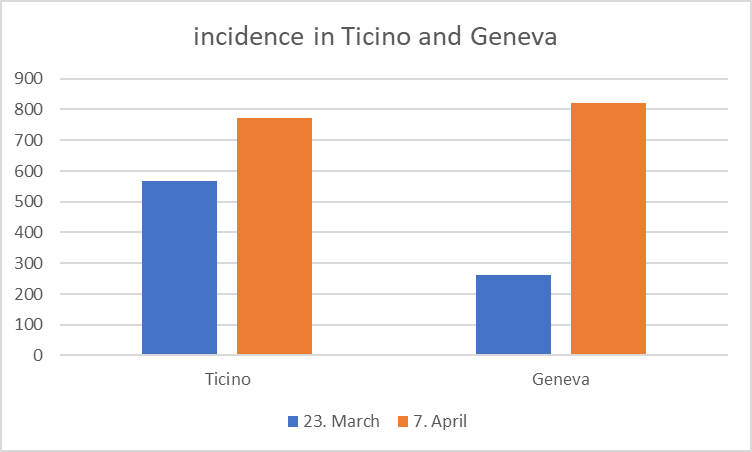
Regarding regional differences, Southern Switzerland has the highest incidence. With 1066 cases per 100,000 inhabitants, Geneva has the highest and with 123.9/100,000 cases Appenzell-Innerrhoden has the lowest incidence. The canton Ticino has the second largest incidence with 994 cases/100,000 inhabitants.
It is remarkable that only Ticino differed from the national measures in a substantive way, even though Geneva has a higher incidence. It is necessary to analyze the incidence more detailed. Tessin passed the total lockdown on 23 March 2020. At that time, Ticino had an incidence of 567,7 cases per 100,000 inhabitants. Geneva in contrast had only 262,9 cases per 100,000 inhabitants. Because of the delay between infection and detection, the effect of the lookdown can be measured two weeks later. On 7 April 2020, Ticino had an incidence of 771.5/100,000, and Geneva had an incidence of 821.5/100,000. In other words, in Geneva, the infections have more than dribbled, while in Ticino had only growth of 36%. In conclusion, the far-reaching lockdown had a huge effect.
It is remarkable that only Ticino differed from the national measures in a substantive way, even though Geneva has a higher incidence. It is necessary to analyze the incidence more detailed. Tessin passed the total lockdown on 23 March 2020. At that time, Ticino had an incidence of 567,7 cases per 100,000 inhabitants. Geneva in contrast had only 262,9 cases per 100,000 inhabitants. Because of the delay between infection and detection, the effect of the lookdown can be measured two weeks later. On 7 April 2020, Ticino had an incidence of 771.5/100,000, and Geneva had an incidence of 821.5/100,000. In other words, in Geneva, the infections have more than dribbled, while in Ticino had only growth of 36%. In conclusion, the far-reaching lockdown had a huge effect.
In the media, Switzerland often was criticized that the easing strategy was too far-reaching. Some newspapers wrote about a second wave. [18] Of course, no one can finally predict what will happen in the next months. But, as the criticized easing came into effect on 6 June 2020, we now (30 July) can observe the effect. For that, I have designed two graphs, one with the daily number of new infections between 6 June and 10 July, and one for the period until 28 July. I wrote this paragraph first on 12 July and edited it in the and of July again. I have decided to provide you both graphs and interpretations because this example shows impressive, how new data can change the retrospective evaluation of measures.
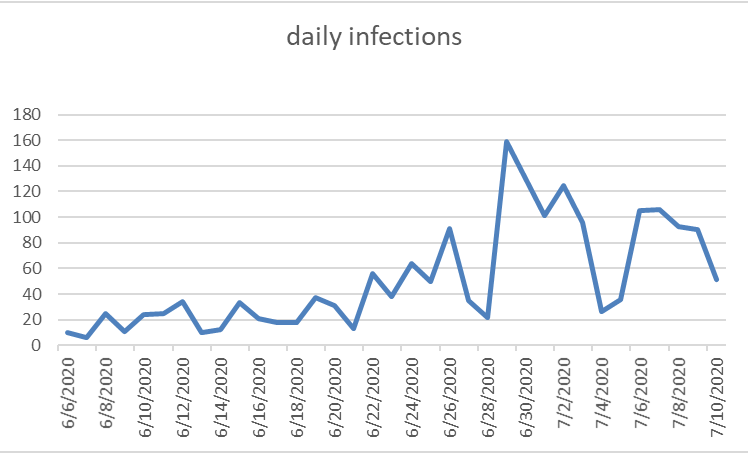
Interpretation from 12 July (unedited): Obviously, the number of daily infections increased rapidly. Nonetheless, in July the number decreased again. The predicted unrestricted exponential growth cannot be confirmed yet. It is quite surprising that in July the new infections decreased again, as during the entire period the same social-distancing measures were valid. One explanation might be that the people became more careful in the context of the increasing infections. Unfortunately, I could not find any current survey, so I cannot confirm this guess. To sum up, we can neither confirm, nor reject the concern of many journalists. The level of new infections now is on a higher level, than before the easing, but still is on a low level compared with March and decreased in the last two weeks. It will be very interesting to observe the future development.

While in the mid of July it seemed like the peak at the end of June, was just a temporary limited increase of infections, we now can see that the number of daily infections is increasing again. In fact, the peak of 158 infections on 29 June has been surpassed on 27 July with 183 infections. The first graph might lead to the conclusion, that the number of daily infections remains at a relatively low level for the next months and that the measures are adequate to counteract against the virus. Relying on the new data, we would probably predict a slow but continuous increase in daily infections. As a conclusion, we might ask for stricter regulations.
We should keep in mind that the authorities had neither the outdated nor the current data when they implemented the measures. The public debate about the capability of the officials to cope with Covid-19 is often reduced to the effect of their measures. In my opinion, we should always keep in mind that no one can predict the effect of easings. We should not only take into consideration whether the officials had luck and had chosen suitable measures but also should consider what seemed to be the best at the time when the measure was implemented.
We should keep in mind that the authorities had neither the outdated nor the current data when they implemented the measures. The public debate about the capability of the officials to cope with Covid-19 is often reduced to the effect of their measures. In my opinion, we should always keep in mind that no one can predict the effect of easings. We should not only take into consideration whether the officials had luck and had chosen suitable measures but also should consider what seemed to be the best at the time when the measure was implemented.
I only dealt with a few key aspects of meaning-making. As all data above of course is outdated, it seemed unsuitable to me to provide meaningless graphs, just to extend my Wiki. I rather recommend clicking on this link: https://covid-19-schweiz.bagapps.ch/de-1.html and use this tool provided by the Swiss health department. It is an interactive map containing all real-time data about cases and death overtime, divided by region, gender, and age. Unfortunately, ILIAS technically does not support this feature, hence I cannot include it to my Wiki page. Furthermore, the map is only published in German and French. For those who do not speak German, I have translated the most important terms below:
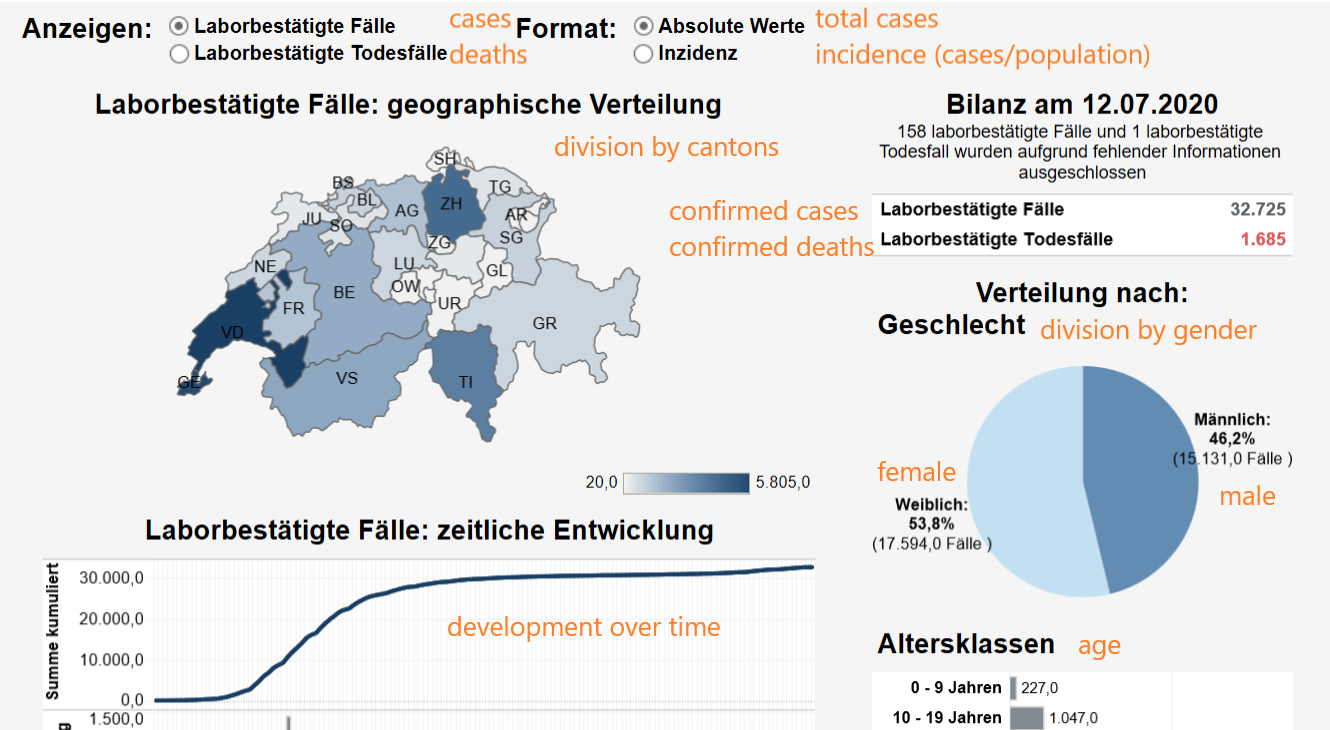
4 Decision-making
4.1 Containing the virus
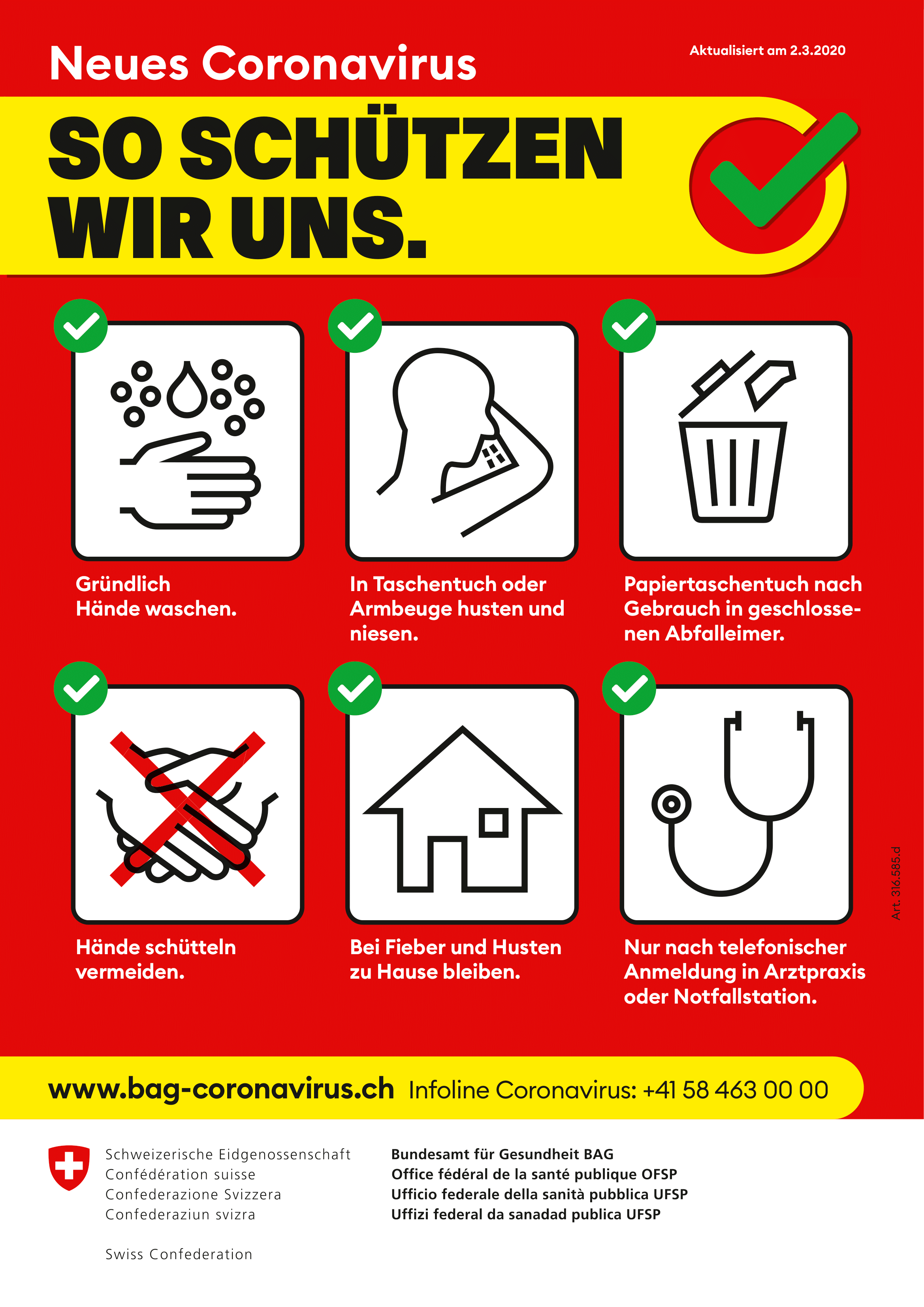
poster "this is how we protect" from 2 March 2020 source: https://fw-rheinfelden.ch/wp-content/uploads/2020/03/plakat_neues_coronavirus_so_schuetzen_wir_uns-1.png
1. January
- On 29 January 2020, the department of Interiors enacted a notification requirement for Covid-19 [19] .
- On 28 February 2020, the federal council declared level one of the epidemic code and prohibited events with more than 1000 participants. [20] [21]
- Further, the health department (BAG) launched a campaign named “this is how we protect ourselves”. Besides a hotline, a campaign-website, and advertisement on the internet, the most important element is print-posters with behavior instructions, which were hung up at all public places, stores, restaurants, and so on. The instructions were adapted multiple times, depending on the respective situation. In March, for example, they asked to stay at home, in July they asked to use the tracing App and keep distance to each other. Publishing these posters in over twenty languages and using pictograms increased its effectiveness. . [22]
- On 11 March, small border crossings to Italy were closed, in order to control who is passing the boarder. At that point, Italy restricted the entry requirements, which partly was controlled by the Swiss border control. [23]
- On 13 March 2020, the federal council prohibited events with more than 100 participants, which caused an abrupt end of the skiing season and limited the number of people in restaurants, clubs, and bars to 50. Further schools were closed until 4 April 2020- which was extended later on. [24]
- In the afternoon of 16 March 2020, the federal council declared level two emergency case of epidemic code, which caused a far-reaching cut of the vertical separation of powers. With effect to midnight, Switzerland closed all stores and prohibited providing services. Exceptions applied to grocery stores, the health system, the transport sector (public transport, gas stations, ...), and other system relevant sectors. Because of low demand, the supply for public transport was reduced drastically. Further, only urgent surgeries were undergone. Moreover, Switzerland closed all borders for foreigners without important reasons like working in Switzerland. From that point, the treaty of Schengen was suspended. All measures were initially limited to 19 April 2020.[25] [26]
- On 17 March 2020, the military convened 8,000 soldiers of the reserve, which was the biggest convention since World War II. They were convened to support the board guards and to avoid a collapse of the health system. . [27]
- On 18 March 2020, the federal council decide to postpone all referendums. A postponing of referendums happened only one time before in the history of Switzerland, also caused by a pandemic. [28]
- On 20 March 2020, gatherings were limited to five persons.[29]
- On 8 April 2020, the federal council extended the restriction for one week, until 26 April 2020, and promised to ease after that. [30]
- On 25 June, Switzerland launched a contact tracing app, called "SwissCovid App". The application is voluntary, work on Android and Apple Smartphone, and uses Bluetooth to detect contact persons. The data is stored anonymized and decentralized. [31] On 23 July, the App has been downloaded over two million times- which means that approximately 25% of the Swiss uses the app. [32] For comparison, in New Zealand 11.7% and in India 8.4% installed the corresponding tracing app.
- On 1 July 2020, the federal council announced mandatory mask-wearing in public transport, valid as of 7 July 2020.[33]
4.2 Counteracting against the consequences of the global lockdown
- Begging in the mid of March, Switzerland organized special flights to return 7,000 Swiss tourists. [34]
- On 13 March 2020, the federal council provided a first economic rescue package with a size of 10 billion CHF (=10,6 billion USD), using in a high degree already existing rescuing mechanism. The most important element is lowering the requirements of the short-time work program (8 billion CHF). Swiss social insurance pays 80% of the omitting wage. If a person works 50% of its usual work time, the employer pays 50% of the wage and the insurance 0.8*0.5= 40% of the wage, which leads to a total wage of 90%. [35]
- On 20 March 2020, the federal council passed the biggest rescue package in Swiss history. Extending the package from 13 March 2020, the new package has now a total volume of 42 billion CHF (=44.5 billion USD). 20 billion CHF is for interest-free loans for small and medium-sized enterprises. Loans up to 500.000 CHF could be applied online and one receives the money “within half an hour”, said finance minister Ueli Maurer. He further stated, that “If more money is needed, we will provide it”. He kept this promise when he doubled the budget for loans from 20 to 40 billion CHF on 3 April 2020. [36]
- On 8 April 2020, the federal council promises a rescue package for the airlines Swiss, Edelweiss, and EasyJet. In the final package, finished at the end of April, Switzerland guarantees for a loan of 1.5 billion CHF for the Lufthansa daughters Swiss and Edelweiss on the condition that the money is only used for Swiss infrastructure and no dividends are paid. Further, all other companies in the aviation sector benefit from a fund of 600 million CHF size. [37]
- On 30 April 2020, the council announced to spend 400 million CHF to support developing countries fighting against Covid-19. The International Red Cross should, therefore, receive a loan of 200 million CHF. The remaining 200 million CHF should be offered as loans for the International Monetary Fund and other aid organizations. [38]
- On 13 Mai, the federal council promises a rescue package for sports clubs and leagues. The package includes loans of 500 million CHF. 175 million of it for ice hockey and football professionals, 150 million CHF for amateur sports clubs, and 175 million CHF for possible losses of earnings in 2021. [39]
4.3 Easing of measuares
- On 16 April 2020, the federal council published its first easing strategy. From 27 April 2020 hairdressing and beauty salons, hardware stores, and garden centers were opened and the restriction on surgeries was annulled. Further, it was planned to open elementary schools, and the remaining stores on 11. Mai. Followed by secondary, professional, and high schools on 8 June. For restaurants, no date was provided yet. [40]
- Due to the low infection number, on 29 April the federal council announced to ease faster. The new (and realized) plan was to open stores, restaurants, libraries, elementary and secondary schools, on 11. Mai. Training in sports clubs was also allowed and the public transport returned to its normal timetable. [41]
- On 13 Mai 2020, the Ministry of Justice announced easing concerning border closing to Germany, Austria, and France with effect to 15 Mai for example for families and a complete opening with effect to 15 June. The border to Italy has been opened unitarian by Italy on 3 June. On 12 June Switzerland announced opening its borders for all EU member states and the UK with effect to 15 June. [42]
- On 20 Mai 2020, the federal council announced that from 28 Mai religious ceremonies like church services were allowed. [43]
- On 27 Mai, the government presented an entire exit strategy, which only prohibits event with more than 1000 participants: [44]
- From 30 Mai, gatherings were limited to 30 people.
- From 6 June, private and public events of all kinds (birthday parties, theater, religious events, …) were limited to 300 persons. Participation in demonstrations requires wearing a face mask (which is not obligatory in other situations). Further amusement parks and other free-time activities were opened. Contact tracing is only required in discotheques and in restaurants for groups of five or bigger. The closing time for all facilities is midnight. Moreover, all types of schools, including professional schools and high schools, were opened.
- From 19 June, Switzerland returned to the level one emergency case, which led to more competences for the cantons. [45]
4.4 sub-state level: cantonal measures
- As above described, level two emergency case of the epidemic code eliminated approximately all cantonal competences. Hence, between 16 March and 19 June, de facto no cantonal measures exist. Even, before and after this period, most cantons passed only a few own measures. In most cases, the sub-state regulations are only a little divergent from the national measures. For example, the cantons Zürich and Schaffhausen require contact tracing in bars. [46]
- Most remarkable is the canton Ticino. Because of its border to Northern Italy, it is the only canton with substantive divergence to the national measures. On 11 March 2020, Ticino closed schools, cinemas, and clubs. Further, gatherings were limited to 50 people. But most decisive was the lockdown between 23 March and 11 Mai. With permission of the federal council, Ticino closed all businesses, which are not systematically relevant. After the total lockdown (from 12 May), Ticino mostly followed the national strategy. The only difference is that gathering is still limited to 30 persons and clubs have a limit of 100 guests. [47] [48]
5 Legitimacy
The polling institute “sotomo” conducted several surveys on behalf of the public service broadcast SRG. Due to a large sample size of approximately 30,000, they have a very small standard error. On the other hand, the data was generated using online surveys without random sampling (opt-in) launched on the websites of SRG and “sotomo”, which leads to an under-representation of for example older people without internet connection and people who do not trust the mass media. The latter might reject the decision-making of the government more likely. The authors corrected this bias by weighting the units. The reliability has been discussed in one of the largest daily newspapers in Switzerland “Blick”. The umbrella organization of polling institutes in Switzerland (Verband der Schweizer Markt- und Sozialforschung) doubted that weighting leads to unbiased results. They further criticized, that reading news on SRG before participating in the survey was a treatment, which leads to more agreement. [49] I have decided to rely on this data anyway for two reasons. First, one should discuss how serious the bias is, as “somoto” encountered it by weighting the data. Second, there are no comparable surveys, which contain data among such a long period of time. The surveys might be biased, but as the methodology is the same among all surveys, its bias is constant, which leads to perfect comparability of the data. In other words, the change is unbiased.
The first survey was published on 23 March 2020, one week after the far-reaching social distancing measures were announced. According to “sotomo”, the overall evaluation of the measure among all policy areas was quite positive. 69% perceived the economic restrictions like closing bars appropriate. 54% perceived the social measures like restrictions on meeting large group appropriate. Only between 4% and 9% (depending on the policy field) perceived the measures as too far-reaching. The broad consent can also be shown in the dimension "trust in political leader". 63% of the Swiss population had high or very high trust. Only 15% had low or very low trust in leader. Older people were more, men were less likely to trust. The impact of party preference was marginal. Concerning regional differences, in German-speaking Switzerland, 71% had trust in leader, whereas in French-speaking Switzerland (43%) and Italian-speaking Switzerland (46%) people had the lowest level of trust in political leader. Those regions preferred earlier and stricter measures, as they feared an overload of the health system. In French-speaking Switzerland, 81% of the polled expected an overload. Regarding communication, which is according to Boin et al. a key concept of meaning-making,[50] only 14% evaluated the communication as bad or very bad. The same regional and social differences as in the dimension “trust in political leader” were observed. Nevertheless, among all subgroups, a majority evaluated the communication positive or rather positive.[51]
The first survey was published on 23 March 2020, one week after the far-reaching social distancing measures were announced. According to “sotomo”, the overall evaluation of the measure among all policy areas was quite positive. 69% perceived the economic restrictions like closing bars appropriate. 54% perceived the social measures like restrictions on meeting large group appropriate. Only between 4% and 9% (depending on the policy field) perceived the measures as too far-reaching. The broad consent can also be shown in the dimension "trust in political leader". 63% of the Swiss population had high or very high trust. Only 15% had low or very low trust in leader. Older people were more, men were less likely to trust. The impact of party preference was marginal. Concerning regional differences, in German-speaking Switzerland, 71% had trust in leader, whereas in French-speaking Switzerland (43%) and Italian-speaking Switzerland (46%) people had the lowest level of trust in political leader. Those regions preferred earlier and stricter measures, as they feared an overload of the health system. In French-speaking Switzerland, 81% of the polled expected an overload. Regarding communication, which is according to Boin et al. a key concept of meaning-making,[50] only 14% evaluated the communication as bad or very bad. The same regional and social differences as in the dimension “trust in political leader” were observed. Nevertheless, among all subgroups, a majority evaluated the communication positive or rather positive.[51]
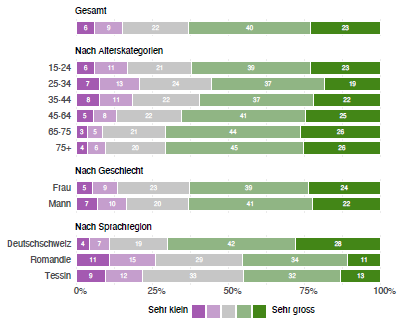

survey 2: expected overload of the health system. comparison of survey 1 and 2. population: all Swiss. green: I expect an overload. purple: I do not expect. source: https://www.srf.ch/news/schweiz/corona-umfrage-der-srg-die-schweiz-ist-optimistischer-geworden
Two weeks after the first survey, SRG published the second one. While in the first survey, especially in French-speaking and Italian-speaking regions some people were concerned as they tended to prefer earlier and stricter measures, now among all groups and regions people a broad majority have high or very high trust in the political leaders. The biggest increase was measured for Italian-speaking Switzerland. The trust increased from 46% to 62%. For all of Switzerland, the value for the dimension “trust in political leader” increased from 63% to 67%. Satisfaction with communication also increased little from 65% to 68%. The differences due to political orientation again were marginal. The most important change is an upcoming group asking for easing of the social distancing policies. On 5 April 2020, 22% of the surveyed perceived the status-quo of closing shops and bars as too restrictive. It has been also asked, how the measures should be adjusted after 19 April 2020 (planned sunset of the ongoing measures). A large group (42%) was in favor of partial, far-reaching, or total repeal of the existing Covid-19 policies. 37% preferred remaining the status-quo. German-speaking and older people were more likely to support relaxation. The upcoming trend of demand for easing can be explained with the decrease of fear about an overload of the health system. While in March three quarters (75%) expected an overload, on 5 April 2020 only one third (31%) were afraid of it. Even in the non-German-speaking regions, a turn was observed. In this survey among all regions and groups, a majority expected the capacity of the health system to be large enough. For the first time, it was asked whether the polled would install a contact tracing app and if they are in favor of mandatory mask-wearing in shops. 65% were willing to install a tracing-app and 39% supported mandatory mask-wearing. [52]
The third survey was released on 7 Mai 2020 and is marked by the far-reaching easing announced on 27 Mai 2020. Sotomo asked whether the polled support the pace of the exit strategy. 42% perceived it too fast, 36% as adequate, and 23% too slow. Like in previous surveys, it turned out, that Italian- and French-speaking regions as well as younger people are more risk-averse. Even though French-speaking regions are over average risk-averse, they became more optimistic than their Italian-speaking compatriots. 47% of the French-speaking, but 62% of the Italian-speaking pooled perceive the pace of the easing strategy as too fast. Concerning the risk of a second wave, this difference between French- and Italian-speaking regions could not be confirmed. About 65% of the polled in those both regions expected an increase of case numbers, while only 51% of the total population expected an increase. Unlike in the previous surveys, we now can see a differentiation depending on party preference. While only 9% of the social democratic party (SP) supporters wish faster easing, 41% of the right-wing SVP supporters perceive the exit strategy as too slow. The desire for faster easing within the SVP electorate can be explained with the business-friendly orientation of the SVP. In general, economic issues became more and more important. While in the first survey only 30% assessed the economic situation bad or very bad, in the third survey the value increased to 57%. The level of trust in leader remains at a high level of 62%. Concerning tracing apps, the support declined to 59%, and concerning mandatory mask-wearing, the support increased to 43%.[53]
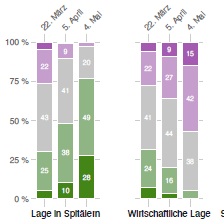
survey 3: evaluation of the situation in the hospitals (left) and economic situation (right)-development over time. population: all Swiss. green: very good. purple: very bad. source: https://www.srf.ch/news/3-corona-umfrage-der-srg-sorgenvoller-aufbruch-in-die-neue-normalitaet
The fourth survey, published on 12 June 2020, shows an upcoming optimism. While in the last survey 57% of the polled evaluated the economic situation as bad or very bad, in June a minority of 44% were that pessimistic. The fear of a second wave also declined from 51% to 26%. It might be an explanation for the growing disapproval of facemasks and tracing apps. In June, only a third of the polled (35%) were in favor of mandatory mask-wearing in shops and 54% were willing to install a tracing app. Both are the lowest values since the beginning of the data collection in April. This survey seems to be a turning point. For the first time, overall groups of ages, regions, and party preferences the easing strategy is seen as to slow or adequate. Even in Italian-speaking Switzerland, only 38% perceive the easing as to fast. The federal council can also profit from the overall optimism. With 66%, the level of “trust in leader” increased by 4%. [54]

survey 4: approval for a tracing app (left) and face-mask requirement (right). data from March, May, June. population: all Swiss(left)- German- French- Italian-speaking(right). green: approval. purple: disapproval source: https://www.srf.ch/news/schweiz/4-srg-corona-umfrage-wie-geht-es-ihnen-und-was-halten-sie-vom-vorgehen-der-behoerden
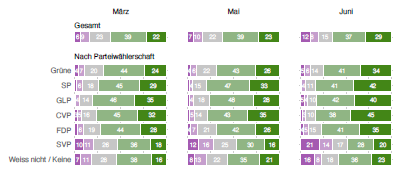
survey 4: trust in leader-development. data from March, May, June. data from: all Swiss (top), green-voters, social-dem, green-liberal, christian-conservative, liberal, conservative-right, no preference (bottom), green: high trust. purple: low trust. source: https://www.srf.ch/news/schweiz/4-srg-corona-umfrage-wie-geht-es-ihnen-und-was-halten-sie-vom-vorgehen-der-behoerden
6 Overall evaluation
6.1 preparedness
In my opinion, Swiss preparation against pandemics was quite effective. The combination of creating a legal basis and developing specific executive plans was the key to success. Neither an executive plan without a legal basis nor a legal basis without a well-developed executive plan can be successful. From a democratic perspective, it might be alarming that all checks and balances - vertical and horizontal- were eliminated. On the other hand, as the cases doubled in a few days at the begging of the pandemic, there was no time to lose. If the default normal procedure were applied, Switzerland would have lost a decisive amount of time and might have caused a collapse of the health system. Boin et al (2017) describe that formal fault lines can prohibit effective acting in crises. They further state that “Detailed divisions of labor for particular types of crisis often prove unsuitable. Few crises or disaster plans survive contact with reality.” (Boin et al, 2017:65).[55] I am convinced that this is not true for the case of Switzerland. Empowering the federal council without limitations means creating a task force among all policy areas. It enables border control as well as school closings, as well as economic support. As mentioned, centralizing power in crises is crucial, nonetheless I would like to criticize the concrete design of the pandemic code. In my opinion, there are not enough requirements for the declaration of the emergency case. Level one is relatively clearly defined. In contrast, level two does not have any further requirements than a not specified “extraordinary situation”. Further, neither a sunset clause nor a parliamentary legitimation exists. Only the federal court can invalidate the measures. Beyond these legal weaknesses, Swiss pandemic preparation is exemplary.
Boin et al. (2017:64) would criticize the high degree of centralization. Described with the term “upscaling dilemma”, they state that federal officials might have more expertise, but are not in contact with the scene. Perhaps this description might be valid in bigger units like the EU, perhaps in other crises with very individual requirements like natural disasters, where it is decisive to bring help to the people might be valid. But especially in the early stage of a pandemic, determined acting is necessary. Further, it seems to be very successful to provide hygienic concepts, which are simple to implement. In Germany media entrepreneurs often felt clueless, how to develop their own hygienic concept. The Swiss handbook for businesses eliminates this fault line.
Boin et al. (2017:64) would criticize the high degree of centralization. Described with the term “upscaling dilemma”, they state that federal officials might have more expertise, but are not in contact with the scene. Perhaps this description might be valid in bigger units like the EU, perhaps in other crises with very individual requirements like natural disasters, where it is decisive to bring help to the people might be valid. But especially in the early stage of a pandemic, determined acting is necessary. Further, it seems to be very successful to provide hygienic concepts, which are simple to implement. In Germany media entrepreneurs often felt clueless, how to develop their own hygienic concept. The Swiss handbook for businesses eliminates this fault line.
6.2 meaning-making
The campaign “this is how we protect ourselves” was the most important element of meaning-making, which is defined as “the attempt to reduce public and political uncertainty and inspire confidence in crisis leaders by formulating and imposing a convincing narrative.” (Boin et al, 2017:79). For several reasons, it was that successful. The first one is that it provides clear instructions. They of course reduce uncertainty because the public knows how to deal with this invisible virus. Telling people that they can fight the virus with measures like washing their hands, gives them the feeling that they personally can fight against the threat, which spreads confidence. Secondly, it creates a clear frame. According to Boin et al (2017:83) a successful frame “offers a credible explanation of what happened, it offers guidance, it instills hope, shows empathy, and suggests that leaders are in control.” Of course, empathy cannot be shown with those posters, but especially the aspect of guidance and control are covered. By adapting behavioral advice of the posters when the cases numbers decreased also instills hope, as it spreads a feeling of normality. The other aspects need to be covered for example by press conferences and interviews. Therefore, this campaign is only one element-but a crucial one. But the most important aspect of this campaign is, that it gives the officials the possibility to create their own narrative independent from the media. Boin et al (2017:81) describe crisis communication as a triangle of mass media, citizenry, and political actors. Hanging up posters at all public places breaks this dependence. The federal department can create and adapt a clear narrative that fits perfectly with their strategy.
6.3 sense-making
Sense-making in a pandemic means getting information about the spread of the disease. Hence, Switzerland declared Covid-19 notifiable on 29 January 2020. One could criticize that this was late, as the virus already arrived in France on 24 January. On the other hand, the first case was detected one month later, hence we can assume that no cases were missed out due to a late notification requirement. Not the notification-requirement, but the little test capacity in March was most problematic. Not being able to record all cases does not only lead to unreliable data, it also can affect the ability to isolate all people who are infected with the coronavirus. The problem with little test capacity of course is unsatisfying, but it is also a global problem and not caused by Swiss mismanagement. France for example also struggled with little test capacity.
6.4 decision-making
Concerning decision-making, of course, a minimum requirement is to take the crisis seriously and not like Jair Bolsonaro deny the virus. He actually "does not regard the crisis triggered by the Covid-19 pandemic as a public health or safety crisis, but (only) as a threat that could trigger an economic recession". [56]
I further would like to pick up my thought I stated in the paragraph "sense-making". Crises are shaped by uncertainty. Missing data and no information about the consequences makes it impossible to act perfectly. One only can guess, which measures will be the best. Ansel& Boin, 2019:1018 explain "Nobody knows when such a crisis will materialize, what the consequences are, who will be involved, and what actions will be required to
stop it".[57] As a consequence, good crisis management means taking all given information into consideration and reevaluate the measures, when the situation is changing or new pieces of information are given. With reference to Pierce and James they state "Our knowledge of (crisis) processes remains fallible and is in
need of constant calibration in the face of emerging doubts and new facts
(James, 1909/1997; Peirce, 1992)." (Ansell&Boin, 2019:1088). This approach of permanent reevaluation of the situation took the Swiss federal council. That they extended the lockdown on 8 April was not surprising as the number of infections still was relatively high and no one knew, which effect easing would have. Actually, this extension was a matter of precaution. But more surprising was the decision to ease faster than planned on 29 April 2020. It was obvious that if this strategy had failed, the legitimacy of the government would have decreased dramatically. As the population was more risk-averse than the government, from a rational choice perspective, there was no incentive for the federal council to ease faster. Nevertheless, the federal council relyed on the small case numbers and was determined to reevaluate the situation, which led to a faster exit-strategy. From a technocratic point of few, this decision was exemplary-from a democratic point of few one could ask, whether politicians should prefer doing what the population demands. Besides this exemplary crisis-management, one measure worked really badly: The SwissCovid App was released on 25 June. This app might be useful against an upcoming second wave, but for the first wave, they missed to develop an app. For comparison, Chile launched its App on 16 April, India on 2 April. Another problem is that this application is neither interoperable with other tracing apps, nor one can use two tracing apps simultaneously. Especially in border regions, the effect decreases massively.
I further would like to pick up my thought I stated in the paragraph "sense-making". Crises are shaped by uncertainty. Missing data and no information about the consequences makes it impossible to act perfectly. One only can guess, which measures will be the best. Ansel& Boin, 2019:1018 explain "Nobody knows when such a crisis will materialize, what the consequences are, who will be involved, and what actions will be required to
stop it".[57] As a consequence, good crisis management means taking all given information into consideration and reevaluate the measures, when the situation is changing or new pieces of information are given. With reference to Pierce and James they state "Our knowledge of (crisis) processes remains fallible and is in
need of constant calibration in the face of emerging doubts and new facts
(James, 1909/1997; Peirce, 1992)." (Ansell&Boin, 2019:1088). This approach of permanent reevaluation of the situation took the Swiss federal council. That they extended the lockdown on 8 April was not surprising as the number of infections still was relatively high and no one knew, which effect easing would have. Actually, this extension was a matter of precaution. But more surprising was the decision to ease faster than planned on 29 April 2020. It was obvious that if this strategy had failed, the legitimacy of the government would have decreased dramatically. As the population was more risk-averse than the government, from a rational choice perspective, there was no incentive for the federal council to ease faster. Nevertheless, the federal council relyed on the small case numbers and was determined to reevaluate the situation, which led to a faster exit-strategy. From a technocratic point of few, this decision was exemplary-from a democratic point of few one could ask, whether politicians should prefer doing what the population demands. Besides this exemplary crisis-management, one measure worked really badly: The SwissCovid App was released on 25 June. This app might be useful against an upcoming second wave, but for the first wave, they missed to develop an app. For comparison, Chile launched its App on 16 April, India on 2 April. Another problem is that this application is neither interoperable with other tracing apps, nor one can use two tracing apps simultaneously. Especially in border regions, the effect decreases massively.
6.5 "overall-overall evaluation"
As an overall evaluation, I perceived the crises-management of Switzerland as really effective. Their determined decision-making prevented situations like in Northern Italy. As my mother lives in Switzerland, I have a lot of experience with their system. I often perceived it as very chaotic because their understanding of federalism leads to thousands of different regulations and no interoperability within the public administration. Nevertheless, they are proud of this strong understanding of federalism. I would never have expected that Switzerland could agree on doing things the same in all cantons and rely on the expertise of the federal council. Declaring level two emergency case of the pandemic code was the key decision of this pandemic. Switzerland can be very happy, that the federal expert did an excellent job. We should also take into account that unlike Taiwan, South Korea and Thailand Switzerland had no experience with SARS or MERS, which caused even more uncertainty as they have never dealt with a pandemic before. Of course, I also have a criticism about their decisions. For example, the long period of boarder closings was retrospective only little useful, as the pandemic situation in some neighbor states like Austria or Germany was similar and one could wonder "who is protecting from whom", but as a conclusion, there is no perfect way to deal with a crisis and overall Switzerland did a great job.
7 Country´s favourite stay at home song
Many Swiss arists released Covid-19 songs. Unfortunately, most of them only released on YouTube, so that there is no reliable data which one is listened the most. Not even one of them charted. To provide a favorite anyway, I have chosen the most viewed Swiss Corona-song on YouTube.
8 sources
[1] https://de.wikipedia.org/wiki/Liste_der_L%C3%A4nder_nach_Bruttoinlandsprodukt_pro_Kopf accessed: 12 July 2020
[2] https://de.wikipedia.org/wiki/Liechtenstein accessed 12 July 2020
[3] https://de.wikipedia.org/wiki/Schweiz accessed 12 July 2020
[4] https://de.wikipedia.org/wiki/Volksabstimmung_%28Schweiz%29 accessed 12 July 2020
[5]
Rhodes, A., Ferdinande, P., Flaatten, H., Guidet, P., Metnitz, G. & Moreno, R. P.. 2012. “The variability of critical care bed numbers in Europe.” [eng]. Intensive care medicine 38 (10): 1647–53.
Rhodes, A., Ferdinande, P., Flaatten, H., Guidet, P., Metnitz, G. & Moreno, R. P.. 2012. “The variability of critical care bed numbers in Europe.” [eng]. Intensive care medicine 38 (10): 1647–53.
[6] Senn, L. 2020. “So viele Intensivbetten hat die Schweiz im Vergleich zu den Nachbarländern.” watson. https://www.watson.ch/international/die%20welt%20in%20karten/454000168-coronavirus-so-viele-intensivbetten-hat-die-schweiz-im-vergleich accessed 7 June 2020.
[7]
Dreher, M., Kersten, A., Bickenbach, J., Balfanz, P., Hartmann, B., Cornelissen, C., et al. 2020. “Charakteristik von 50 hospitalisierten COVID-19-Patienten mit und ohne ARDS.” Deutsche Ärzteblatt International 117 (16): 271–78.
Dreher, M., Kersten, A., Bickenbach, J., Balfanz, P., Hartmann, B., Cornelissen, C., et al. 2020. “Charakteristik von 50 hospitalisierten COVID-19-Patienten mit und ohne ARDS.” Deutsche Ärzteblatt International 117 (16): 271–78.
[8]
https://www.rki.de/DE/Content/InfAZ/N/Neuartiges_Coronavirus/Steckbrief.html#doc13776792bodyText19 accessed: 7 June 2020
https://www.rki.de/DE/Content/InfAZ/N/Neuartiges_Coronavirus/Steckbrief.html#doc13776792bodyText19 accessed: 7 June 2020
[9] https://www.bag.admin.ch/bag/de/home/das-bag/publikationen/broschueren/publikationen-uebertragbare-krankheiten/pandemieplan-2018.html accessed: 6 June 2020
[10] https://www.bag.admin.ch/bag/de/home/das-bag/publikationen/broschueren/publikationen-uebertragbare-krankheiten/pandemiebroschuere.html accessed 6 June 2020
[11] https://www.admin.ch/opc/de/classified-compilation/20071012/index.html accessed: 15 June 2020
[12] https://www.bag.admin.ch/dam/bag/de/dokumente/mt/k-und-i/aktuelle-ausbrueche-pandemien/2019-nCoV/bisherige-lageberichte-zip.zip.download.zip/Epidemiologische_Lage_Schweiz.zip accessed: 41 July 2020
[13] https://coronavirus.jhu.edu/map.html accessed: 12 July 2020
[14] https://www.admin.ch/opc/de/official-compilation/2020/359.pdf accessed: 15 June 2020
[15] https://www.bag.admin.ch/dam/bag/de/dokumente/mt/msys/verdachts-meldekriterien-2019-n-cov.pdf.download.pdf/ADM_200421_Verdachts-%20und%20Meldekriterien%20COVID_d.pdf accessed: 27 June 2020
[16] Blum, G. 2020. Röhrli-Engpass bei Corona-Tests. blick.ch. https://www.blick.ch/news/politik/kapazitaeten-am-limit-roehrli-engpass-bei-corona-tests-id15805888.html accessed 22 June 2020
[17] https://de.wikipedia.org/wiki/Inzidenz_(Epidemiologie) accessed: 12 July 2020
[18] Kirchner, T. 2020. Zweite Infektionswelle erfasst die Schweiz. Süddeutsche Zeitung. https://www.sueddeutsche.de/politik/schweiz-coronavirus-corona-1.4954939 accessed: 2 July 2020
[19] https://www.admin.ch/opc/de/official-compilation/2020/359.pdf accessed: 12 July 2020
[20] https://www.suedkurier.de/region/hochrhein/kreis-waldshut/Verbot-von-Grossveranstaltungen-in-der-Schweiz-Basler-Fasnacht-ist-abgesagt;art372586,10455881 accessed: 5 June 2020
[21] https://www.srf.ch/news/schweiz/gestuetzt-auf-epidemiengesetz-bundesrat-ruft-besondere-lage-aus-was-heisst-das accessed: 5 June 2020
[22] https://www.bag.admin.ch/bag/de/home/das-bag/aktuell/medienmitteilungen.msg-id-78273.html accessed: 5 June 2020
[23] https://www.admin.ch/gov/de/start/dokumentation/medienmitteilungen.msg-id-78412.html accessed: 5 June 2020
[24] https://www.admin.ch/gov/de/start/dokumentation/medienmitteilungen.msg-id-78437.html accessed: 5 June 2020
[25] https://www.admin.ch/gov/de/start/dokumentation/medienmitteilungen.msg-id-78454.html accessed: 5 June 2020
[26] https://www.admin.ch/gov/de/start/dokumentation/medienmitteilungen.msg-id-78452.html accessed: 5 June 2020
[27] https://www.nzz.ch/schweiz/coronavirus-armee-mit-groesstem-aufgebot-seit-dem-2-weltkrieg-ld.1546715 accessed: 5 June 2020
[28] https://www.admin.ch/gov/de/start/dokumentation/medienmitteilungen.msg-id-78485.html accessed: 5 June 2020
[29] https://www.admin.ch/gov/de/start/dokumentation/medienmitteilungen.msg-id-78513.html accessed: 5 June 2020
[30] https://www.admin.ch/gov/de/start/dokumentation/medienmitteilungen.msg-id-78744.html accessed: 5 June 2020
[31] https://bag-coronavirus.ch/swisscovid-app/#function accessed: 20 July 2020
[32] https://www.bag.admin.ch/bag/de/home/das-bag/aktuell/news/news-23-07-2020.html accessed: 30 July 2020
[33] https://www.admin.ch/gov/de/start/dokumentation/medienmitteilungen.msg-id-79711.html accessed: 15 July 2020
[34] https://www.swissinfo.ch/ger/-flyinghome-switzerland-in-der-corona-krise_groesste-rueckholaktion-in-der-schweizer-geschichte/45679816 accessed: 5 June 2020
[35] https://www.admin.ch/gov/de/start/dokumentation/medienmitteilungen/bundesrat.msg-id-78515.html accessed: 5 June 2020
[36] https://www.admin.ch/gov/de/start/dokumentation/medienmitteilungen/bundesrat.msg-id-78515.html accessed: 5 June 2020
[37] https://www.schwarzwaelder-bote.de/inhalt.toechter-swiss-und-edelweiss-lufthansa-erhaelt-erste-staatshilfen-aus-der-schweiz.f153a590-06c5-4cfd-aa1b-77d2d27c8c75.html accessed: 5 June 2020
[38] https://www.admin.ch/gov/de/start/dokumentation/medienmitteilungen.msg-id-78956.html accessed: 5 June 2020
[39] https://www.admin.ch/gov/de/start/dokumentation/medienmitteilungen.msg-id-79090.html accessed: 6 June 2020
[40] https://www.admin.ch/gov/de/start/dokumentation/medienmitteilungen.msg-id-78818.html accessed: 28 June 2020
[41] https://www.admin.ch/gov/de/start/dokumentation/medienmitteilungen.msg-id-78930.html accessed: 28 June 2020
[42] https://www.srf.ch/news/schweiz/grenzoeffnung-ab-15-juni-bis-mitte-juni-braucht-es-triftige-gruende-fuer-reisen accessed: 28 June 2020
[43] https://www.admin.ch/gov/de/start/dokumentation/medienmitteilungen.msg-id-79204.html accessed: 28 June 2020
[44] https://www.admin.ch/gov/de/start/dokumentation/medienmitteilungen.msg-id-79268.html accessed: 28 June 2020
[45] https://www.nau.ch/news/schweiz/auf-die-ausserordentliche-folgt-die-besondere-lage-65725999 accessed: 28 June 2020
[46] https://www.bluewin.ch/de/newsregional/ost/ausweispflicht-nun-auch-in-schaffhauser-bars-und-clubs-412618.html accessed: 28 June 2020
[47] https://www.zentralplus.ch/tessin-lockert-corona-massnahmen-1787949/ accessed: 28 June 2020
[48] https://www.srf.ch/news/schweiz/corona-lockdown-im-tessin-die-bilder-aus-italien-machen-immer-noch-angst accessed: 28 June 2020
[49] https://www.blick.ch/politik/systematischer-fehler-krach-um-srg-corona-umfrage-id15819065.html accessed: 15 June 2020
[50] Boin, A., Hart, H., Stern, E., Sundelius, B. 2017. The politics of crisis management: Public leadership under pressure [eng]. Cambridge: Cambridge University Press
[51] https://www.srf.ch/news/schweiz/umfrage-der-srg-so-denkt-die-schweiz-ueber-die-corona-krise accessed: 29 June 2020
[52] https://www.srf.ch/news/schweiz/corona-umfrage-der-srg-die-schweiz-ist-optimistischer-geworden accessed: 29 June 2020
[53] https://www.srf.ch/news/3-corona-umfrage-der-srg-sorgenvoller-aufbruch-in-die-neue-normalitaet accessed: 29 June 2020
[54] https://www.srf.ch/news/schweiz/4-srg-corona-umfrage-wie-geht-es-ihnen-und-was-halten-sie-vom-vorgehen-der-behoerden accessed: 29 June 2020
[55] Boin, Arjen, Paul 't Hart, Erik Stern, and Bengt Sundelius. 2017. The politics of crisis management: Public leadership under pressure [eng]. Cambridge: Cambridge University Press.
[57] Ansell, B., Boin, A. 2019. Taming Deep Uncertainty: The Potential of Pragmatist Principles for Understanding and Improving Strategic Crisis Management. Administration & Society
2019, Vol. 51(7) 1079–1112
2019, Vol. 51(7) 1079–1112